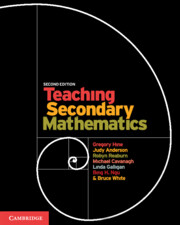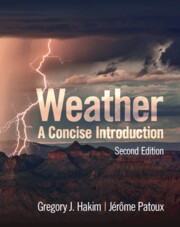Refine search
Actions for selected content:
36856 results in Cambridge Textbooks
Contents
- from Chapter 2 - Spatial Representations of Weather Data
-
- Book:
- Weather
- Published online:
- 26 October 2021
- Print publication:
- 28 October 2021, pp 20-45
-
- Chapter
- Export citation
Chapter 7 - Precipitation
-
- Book:
- Weather
- Published online:
- 26 October 2021
- Print publication:
- 28 October 2021, pp 130-140
-
- Chapter
- Export citation
Introduction
-
- Book:
- Weather
- Published online:
- 26 October 2021
- Print publication:
- 28 October 2021, pp xiii-xiv
-
- Chapter
- Export citation
Chapter 14 - Air Pollution
-
- Book:
- Weather
- Published online:
- 26 October 2021
- Print publication:
- 28 October 2021, pp 256-265
-
- Chapter
- Export citation
Copyright page
-
- Book:
- Weather
- Published online:
- 26 October 2021
- Print publication:
- 28 October 2021, pp iv-iv
-
- Chapter
- Export citation
Index
-
- Book:
- Weather
- Published online:
- 26 October 2021
- Print publication:
- 28 October 2021, pp 297-306
-
- Chapter
- Export citation
Preface
-
- Book:
- Weather
- Published online:
- 26 October 2021
- Print publication:
- 28 October 2021, pp xi-xii
-
- Chapter
- Export citation
Glossary
-
- Book:
- Weather
- Published online:
- 26 October 2021
- Print publication:
- 28 October 2021, pp 280-291
-
- Chapter
- Export citation
Contents
- from Chapter 4 - Heat and Energy Transfer
-
- Book:
- Weather
- Published online:
- 26 October 2021
- Print publication:
- 28 October 2021, pp 59-82
-
- Chapter
- Export citation
Chapter 4 - Heat and Energy Transfer
-
- Book:
- Weather
- Published online:
- 26 October 2021
- Print publication:
- 28 October 2021, pp 59-82
-
- Chapter
- Export citation
Chapter 6 - Cloud Formation
-
- Book:
- Weather
- Published online:
- 26 October 2021
- Print publication:
- 28 October 2021, pp 99-129
-
- Chapter
- Export citation
Chapter 13 - Weather Forecasting
-
- Book:
- Weather
- Published online:
- 26 October 2021
- Print publication:
- 28 October 2021, pp 240-255
-
- Chapter
- Export citation
Contents
- from Chapter 12 - Tropical Cyclones
-
- Book:
- Weather
- Published online:
- 26 October 2021
- Print publication:
- 28 October 2021, pp 226-239
-
- Chapter
- Export citation
Contents
- from Chapter 13 - Weather Forecasting
-
- Book:
- Weather
- Published online:
- 26 October 2021
- Print publication:
- 28 October 2021, pp 240-255
-
- Chapter
- Export citation
Contents
- from Chapter 11 - Thunderstorms and Tornadoes
-
- Book:
- Weather
- Published online:
- 26 October 2021
- Print publication:
- 28 October 2021, pp 209-225
-
- Chapter
- Export citation
Chapter 5 - Water
-
- Book:
- Weather
- Published online:
- 26 October 2021
- Print publication:
- 28 October 2021, pp 83-98
-
- Chapter
- Export citation
Contents
- from Chapter 6 - Cloud Formation
-
- Book:
- Weather
- Published online:
- 26 October 2021
- Print publication:
- 28 October 2021, pp 99-129
-
- Chapter
- Export citation
Contents
- from Chapter 10 - Air Masses, Fronts, and Midlatitude Cyclones
-
- Book:
- Weather
- Published online:
- 26 October 2021
- Print publication:
- 28 October 2021, pp 186-208
-
- Chapter
- Export citation

Teaching Secondary Mathematics
-
- Published online:
- 27 October 2021
- Print publication:
- 24 September 2021
-
- Textbook
- Export citation

Weather
- A Concise Introduction
-
- Published online:
- 26 October 2021
- Print publication:
- 28 October 2021
-
- Textbook
- Export citation
